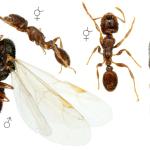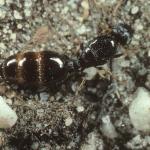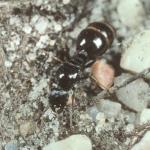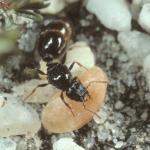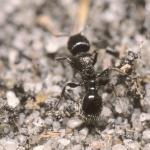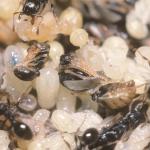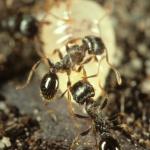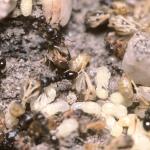This is the commonest species of this widespread genus to be found in Britain; some other tramp species may occur sporadically. The workers are small (2.5-4 mm) and dark brown or black with a robust morphology typical of myrmecine ants. All castes have a two-segmented 'waist' and pectinate spurs on all tibiae, along with propodeal spines and a sting in the females. Despite its size, T. caespitum is an aggressive ant and uses its sting freely; it is often the dominant ant species where abundant. There is a marked dimorphism between the castes with males and gynes being much larger than the workers at 5.5-8 mm. There is normally only one queen per colony.
This species occurs predominantly along the south coast of England and up the west coast as far as North Wales, the Isle of Man, Ailsa Craig, Canna and West Sutherland. On the east coast there are records as far as north Norfolk, with a notable gap until the Berwickshire coast. The species is also recorded from coastal sites along southern and south-eastern Ireland. Inland, T. caespitum is found on some lowland heaths and south-facing hillsides in southern and eastern England.
This species is not regarded as being scarce or threatened.
The ant is a highly thermophilous species in Britain and it is mainly found in exposed, rocky coastal areas with short, sparse maritime vegetation. It is also found on some lowland heaths with short or patchy vegetation and a few south-facing rocky or sparsely vegetated slopes inland. It may be locally abundant at particularly suitable sites and it is often found with similarly thermophilous species such as Lasius alienus.
In Britain the mating flights of this species occur from late June to early August.
Nests are formed in sandy or peaty ground, under stones and in rock crevices. The surrounding vegetation is often sparse or close growing, allowing a high degree of insolation at the exposed nest surface. There is rarely an obvious surface structure, although some vegetation fragments may be loosely heaped up around plant stems near nest entrances. Colonies can be extremely populous and nests may be large ramifying structures with tunnels leading great distances; it is notoriously difficult to find the centre of a T. caespitum nest or the nest queen. At coastal sites, nests are usually found on crumbling, rocky cliff tops as far down as the high water line.
Workers forage by predation on other arthropods and by scavenging; they also feed on honeydew from root aphids. Seeds of herbs and grasses are also taken into their nest. The workers forage individually but can rapidly recruit other workers and form a trail to large food sources.
In Britain the rare socially parasitic ant species Strongylognathus testaceus and Tetramorium atratulum are found exclusively with T. caespitum.
2024


